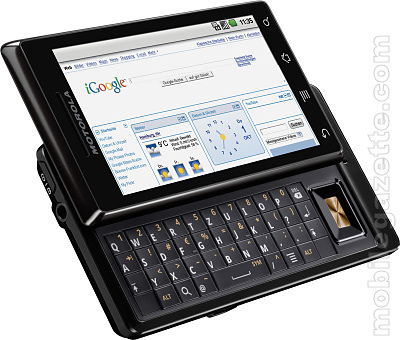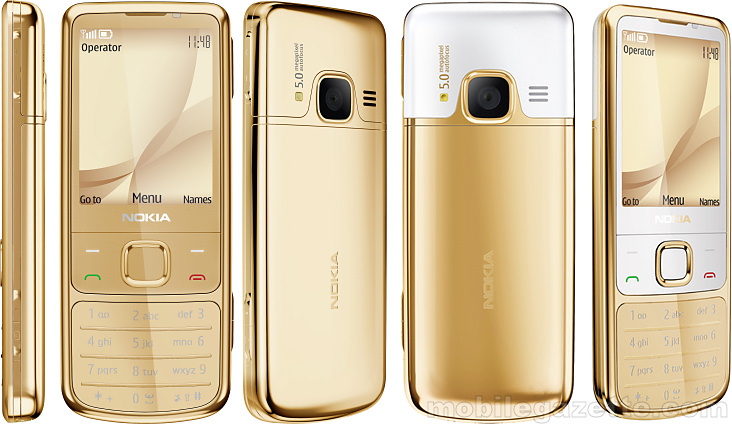
The handset might look familiar, and that's because the hardware
As with the 5230, the Nokia 5235 comes with a 3.2" 640 x 360 pixel touchscreen display, microSD expandable memory, Bluetooth
There's no WiFi support on the 5235, but it does support HSDPA downloads of up to 3.6 Mbps. If you want WiFi, then our recommendation is to go for the 5800 instead.
We mentioned the 2 megapixel camera, which is the same unit as found on the 5230. Really, it's pretty poor when it comes to stills photographs, but it can capture video at up to 640 x 480 pixels at 30 frames per second which is rather good, and certainly good enough for uploading to YouTube.
The Nokia 5235 works with Facebook, MySpace, Ovi and YouTube, and because this is an S60 smartphone then there are a load of applications
We keep talking about price - so how much is the Nokia 5235? Nokia say that the handset should retail for around €145 before tax and subsidy, around the same as the current 5230. The 5235 offers very good value for money even before you take into account the music downloads, so if you take advantage of Comes With Music then this looks like a real bargain.
It is perhaps worth noting that the 5235 doesn't come with a memory card in the standard sales package, but it does include a wired headset. Some of Nokia's data sheets say that it includes a USB cable, whereas others say that it doesn't.. so if you need a USB cable, check before ordering.
Nokia say that the 5235 Comes With Music should be available during Q1 2010 in White or Black colour schemes, each with an ice-blue tinted chrome rim.
Nokia 5235 Comes With Music at a glance
Available:
Q1 2010
Network:
GSM 850 / 900 / 1800 / 1900 +
UMTS 900 / 2100 or
UMTS 850 / 1900 or
UMTS 850 / 2100
Data:
GPRS + EDGE + UMTS (3G) + HSDPA
Screen:
3.2" 640 x 360 pixels, 16m colours
Camera:
2 megapixels
Size:
PDA-style device
111 x 52 x 15mm / 113 grams
Bluetooth:
Yes
Memory card:
MicroSD
Infra-red:
No
Polyphonic:
Yes
Java:
Yes
GPS:
Yes
OS:
Symbian S60 5th Edition
Battery life:
5 hours talk / 19 days standby (3G)
7 hours talk / 18 days standby (GSM)


 From the front, both the Elm and Hazel have a very standard layout, but one novel and elegant feature is the way that the back of the phone is curved to fit into the palm of the user's hand, something that is particularly noticeable on the Elm. This is a very simple piece of industrial design, but it certainly makes these two handsets more noticeable and we suspect that we will see it on other phones in the future too.
From the front, both the Elm and Hazel have a very standard layout, but one novel and elegant feature is the way that the back of the phone is curved to fit into the palm of the user's hand, something that is particularly noticeable on the Elm. This is a very simple piece of industrial design, but it certainly makes these two handsets more noticeable and we suspect that we will see it on other phones in the future too.







 Although the camera seems a little basic, it does have autofocus, dual LED flash and can capture widescreen 720 x 480 pixel video at 24 frames per second. The new version of Android also has significantly improved camera
Although the camera seems a little basic, it does have autofocus, dual LED flash and can capture widescreen 720 x 480 pixel video at 24 frames per second. The new version of Android also has significantly improved camera  There's no exact word on availability, except that we know Germany and Italy will see it first. O2 Germany's
There's no exact word on availability, except that we know Germany and Italy will see it first. O2 Germany's 





 There's no getting away from the slightly retro looks that the small screen brings, but it's quite a smart looking device and very obviously a Nokia. Good spacing between the keys means that the 1280 should be easy to use, even if wearing gloves.
There's no getting away from the slightly retro looks that the small screen brings, but it's quite a smart looking device and very obviously a Nokia. Good spacing between the keys means that the 1280 should be easy to use, even if wearing gloves.



 The HTC HD2 has built-in GPS with a digital compass plus HTC's Footprints application. Because this is a Windows Mobile device, then there are a variety of personal navigation applications available.
The HTC HD2 has built-in GPS with a digital compass plus HTC's Footprints application. Because this is a Windows Mobile device, then there are a variety of personal navigation applications available. YouTube. This is all in addition to the usual Windows Mobile features. The software also has some nice touches such as automatically updating for your local time zone when you travel, and the weather tool has some cool animations to give you a feeling for the weather outside.
YouTube. This is all in addition to the usual Windows Mobile features. The software also has some nice touches such as automatically updating for your local time zone when you travel, and the weather tool has some cool animations to give you a feeling for the weather outside.
 In addition, the camera comes with a Xenon and LED flash (why just have the one?), plus the same intelligent autofocus system as the Pixon 12 plus all the usual clever features that Samsung put into their cameraphones. The AMOLED 12M can move from shot to shot in just two seconds, which is a lot faster than most similar handsets.
In addition, the camera comes with a Xenon and LED flash (why just have the one?), plus the same intelligent autofocus system as the Pixon 12 plus all the usual clever features that Samsung put into their cameraphones. The AMOLED 12M can move from shot to shot in just two seconds, which is a lot faster than most similar handsets. 


 LG have given the GD510 Pop a very narrow bezel around the screen, just 4.8mm along the left and right hand sides. In other words, the Pop is a very compact phone despite the large screen size. There id a single multifunction button on the front and a few ancillary keys around the edge, but otherwise the LG GD510 has a very minimalist design.
LG have given the GD510 Pop a very narrow bezel around the screen, just 4.8mm along the left and right hand sides. In other words, the Pop is a very compact phone despite the large screen size. There id a single multifunction button on the front and a few ancillary keys around the edge, but otherwise the LG GD510 has a very minimalist design.
 The QWERTY keyboard on the B3310 is a little unconventional too - the bottom row of letters is split by a small space bar and a key labelled SYM, and overall the arrangement is very compact but it could be annoying for some users.
The QWERTY keyboard on the B3310 is a little unconventional too - the bottom row of letters is split by a small space bar and a key labelled SYM, and overall the arrangement is very compact but it could be annoying for some users.

 The hardware itself is pretty impressive. There's a large 3.5" 800 x 480 pixel AMOLED touchscreen, a 5 megapixel camera with autofocus and flash, GPS plus a navigation client, HSDPA and HSUPA support with maximum transfer speeds of 7.2 Mbps and 5.6 Mbps respectively, dual band UMTS and WiFi.
The hardware itself is pretty impressive. There's a large 3.5" 800 x 480 pixel AMOLED touchscreen, a 5 megapixel camera with autofocus and flash, GPS plus a navigation client, HSDPA and HSUPA support with maximum transfer speeds of 7.2 Mbps and 5.6 Mbps respectively, dual band UMTS and WiFi. The Vodafone 360 H1 comes with the Opera web browser with support for Webkit widgets, an email client with support for push messaging and a remote lock-and-wipe capability if the phone goes missing. Of course, the H1 also supports Vodafone's 360 service out of the box, and Vodafone say that there should be 1000 applications available to download when the service goes live.
The Vodafone 360 H1 comes with the Opera web browser with support for Webkit widgets, an email client with support for push messaging and a remote lock-and-wipe capability if the phone goes missing. Of course, the H1 also supports Vodafone's 360 service out of the box, and Vodafone say that there should be 1000 applications available to download when the service goes live.
 But now, the S3650 turns up bearing the name "Corby", apparently named after another
But now, the S3650 turns up bearing the name "Corby", apparently named after another  Samsung say that the Corby integrates with social networking sites such as Facebook, MySpace, YouTube and Flickr via a set of "widgets", however the S3650 is a GSM-only device, so it doesn't support 3G (or WiFi) which means that uploads and downloads will be quite slow.
Samsung say that the Corby integrates with social networking sites such as Facebook, MySpace, YouTube and Flickr via a set of "widgets", however the S3650 is a GSM-only device, so it doesn't support 3G (or WiFi) which means that uploads and downloads will be quite slow.
 It's not just about social networking, the MOTOBLUR can also integrate with corporate email systems such as Microsoft Exchange, and of course it supports standard Internet protocols and SMS messaging too. The Motorola CLIQ / DEXT can pull down contacts from all the different messaging systems, with an aim to make the CLIQ / DEXT a single unified point to manage disparate services.
It's not just about social networking, the MOTOBLUR can also integrate with corporate email systems such as Microsoft Exchange, and of course it supports standard Internet protocols and SMS messaging too. The Motorola CLIQ / DEXT can pull down contacts from all the different messaging systems, with an aim to make the CLIQ / DEXT a single unified point to manage disparate services. We've talked a lot about the software and services that accompany this offering, but the hardware is important too. There's a large 3.1" 320 x 480 pixel touchscreen display on the front, a fairly conventional slide-out QWERTY keyboard along the long edge of the device, a 5 megapixel camera with autofocus and geo-tagging, GPS with an embedded compass, stereo Bluetooth, WiFi and tri-band UMTS plus HSDPA download speeds of up to 7.2 Mbps.
We've talked a lot about the software and services that accompany this offering, but the hardware is important too. There's a large 3.1" 320 x 480 pixel touchscreen display on the front, a fairly conventional slide-out QWERTY keyboard along the long edge of the device, a 5 megapixel camera with autofocus and geo-tagging, GPS with an embedded compass, stereo Bluetooth, WiFi and tri-band UMTS plus HSDPA download speeds of up to 7.2 Mbps.  This is the first of many MOTOBLUR handsets. Motorola will announce another one for 2009 launch very soon, and they intend to launch several more Android devices during 2010. T-Mobile and Motorola hope to have the CLIQ (and presumably MOTOBLUR) available by the end of November 2009, in Titanium and Winter White colour schemes.
This is the first of many MOTOBLUR handsets. Motorola will announce another one for 2009 launch very soon, and they intend to launch several more Android devices during 2010. T-Mobile and Motorola hope to have the CLIQ (and presumably MOTOBLUR) available by the end of November 2009, in Titanium and Winter White colour schemes.
